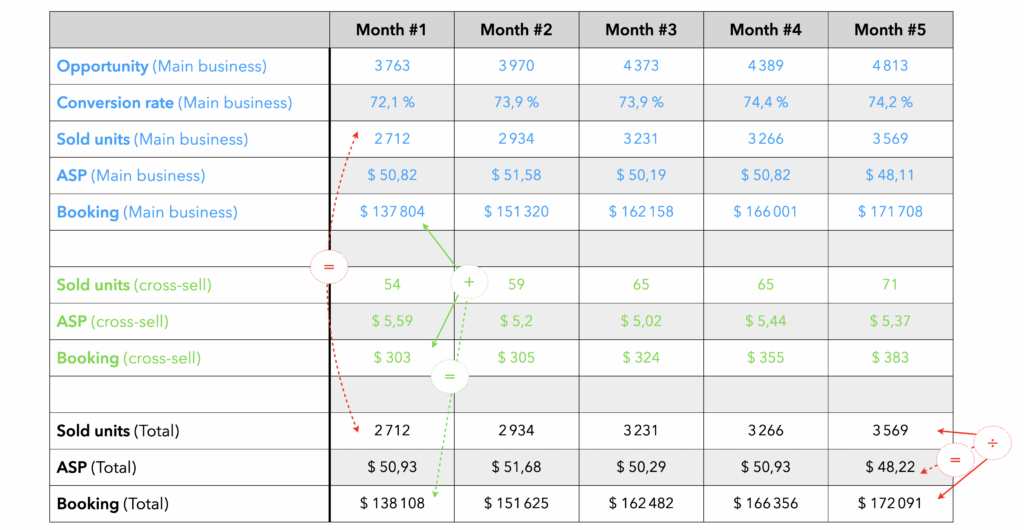How to Monitor Your Business in Practice? – Part 3
In the first part, we created a monitoring table for a monthly subscription business and reconciled Acquisition and Retention.
In the second part, we adapted the table to monitor an annual subscription business.
Now, in this final part, we cover monitoring cross-sell sales:
- What new difficulty does it introduce?
- What are the different possible approaches?
1. Types of cross-sell and their impacts
In a subscription business, there are two types of cross-sell:
- Subscription Cross-sell: A secondary subscription sold in addition to the main one, renewing at a lower price.
- One-shot cross-sell: A one-time purchase, not a subscription.
Depending on the type of cross-sell, there are subtleties. For the same price:
- The booking is identical
- But the revenue is different. For an annual subscription, the revenue will be recognized over 12 months. For a one-shot purchase, the entire booking will be recognized at the time of sale
- The year of the sale, the ASP increases identically for both types of cross-sell
- But the following year, the ASP of the one-shot cross-sell returns to its previous level.📉 For the subscription, the ASP remains at its new level.
2. How to monitor cross-sell sales
There are 2 possible approaches depending on the type of cross-sell, the size of the cross-sell business and its impact on the main business. The length of the subscription, monthly or annual, doesn’t matter.
a. Cross-sell treated as a simple increase in the ASP (Average Selling Price)
In this case, we report cross-sell sales in units and bookings separately in order to measure the evolution of this additional business as well as its size compared to the main business.
Then, we reconcile only the booking, not the units. Since the booking has increased, but the units remain unchanged, only the ASP increases.
This method treats cross-sell sales only as a booking increase factor. Since it doesn’t change the number of subscriptions sold, the next year’s opportunity remains unchanged. This method requires fewer efforts in term of maintenance compared to the others.
This calculation method is ideal when:
- Cross-sells are mainly one-shot sales
- When the share of cross-sells is low compared to the total business
- When cross-sell subscriptions do not have a significant impact on the retention rate
Example of a monitoring table (based on the table from article part 2)

Table #1 : example of monitoring table. Main business (blue), Cross-sell (green), Total (black)
b. Cross-sell treated as a separate activity
In this case, cross-sell sales are reported identically to subscription sales with an Acquisition share and a Retention share.
This is a more detailed approach. It requires as much effort to maintain as monitoring the main business.
This monitoring method is suitable when:
- Cross-sells are only subscriptions
- When the share of cross-sells is significant among the total business
- When the retention rate is impacted by the presence of the cross-sell subscription
The monitoring table will be identical to that of monthly or annual subscriptions as presented in the article part 1 and part 2.
c. Stand-alone Subscriptions vs. Bundles
When treating cross-selling as a separate activity, there are 2 ways to report cross-selling sales:
Either the cross-sell subscription is considered a “stand-alone” subscription and is reported as an independent subscription
Or the main subscription and the cross-sell are considered a bundle. The bundles are reported separately.
🚧 This second type of reporting only works if the 2 subscriptions are renewed together 🚧. This method makes it easy to compare performance by product (retention rate, ASP, engagement, up-sell rate, etc.) depending on whether a subscription is linked to a cross-selling or not.
d. The impact of cross-selling on the retention rate
The presence of the cross-selling subscription increases the total price of the renewal. The more price-sensitive customers are, the more the presence of cross-selling is likely to lower the retention rate.
Therefore it’s necessary to monitor the retention rate of products with and without cross-sell and to verify its relevance in the long term with a CLV analysis (see my article on CLV).
Key Takeaways about Monitoring (all 3 parts)
- Monitoring annual subscriptions and monthly subscriptions must be kept separate.
- Monitoring annual subscriptions requires adjustments based on the billing window and use of the conversion rate as a proxy for the retention rate.
- There are several options for monitoring cross-sells, you need to identify the one that is most suited to your own business.



